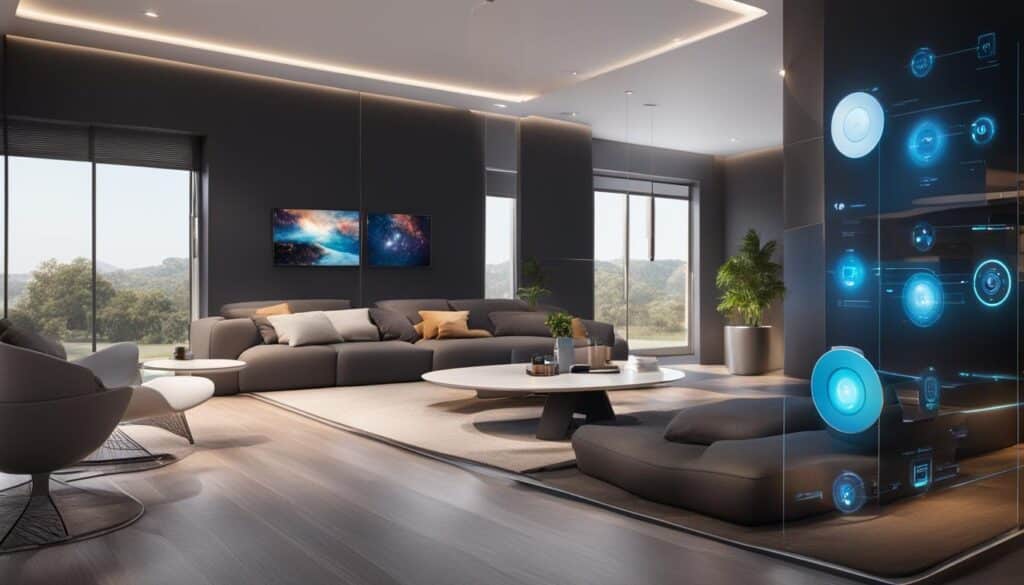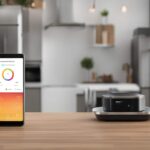Welcome to our comprehensive tutorial on home automation using IoT. In this guide, I will share with you everything you need to know about harnessing the power of the Internet of Things (IoT) to transform your home into a smart, automated oasis. From the basics of getting started to the exciting applications and components involved, we will cover it all.
With the advancements in IoT technology, home automation has become increasingly popular. People are now enjoying the convenience, comfort, and energy efficiency that a smart home offers. Whether you’re interested in controlling your lights, appliances, or even monitoring your home’s security, IoT can make it all possible.
This tutorial is designed to be your go-to resource for all things home automation. Whether you’re a DIY enthusiast or someone looking to implement a professionally-built system, this guide will provide you with the knowledge and tools you need to get started.
Table of Contents
Key Takeaways:
- Home automation using IoT allows you to control and monitor various aspects of your home for convenience and energy efficiency.
- Getting started with IoT home automation involves understanding hardware, software, and communication protocols.
- Home automation has applications in lighting control, HVAC management, home safety, and security, among others.
- Components of home automation include sensors, gateways, protocols, firmware, cloud, and databases.
- IoT platforms play a crucial role in managing and integrating the components of a home automation system.
Getting Started with IoT Home Automation
To embark on your journey into IoT home automation, it’s crucial to grasp the key components that make it all possible. These components encompass the hardware, software/apps, and communication protocols that form the foundation of a seamless and truly smart home experience. By understanding their roles, you can build a robust and efficient system tailored to your specific needs.
The Hardware:
The hardware aspect of IoT home automation involves selecting the right devices and sensors to bring intelligence to your home. Whether it’s smart thermostats, lighting systems, or security cameras, having the right hardware is essential for creating a connected ecosystem. It allows for iterative development of your IoT prototype and enables you to customize your smart home experience to suit your preferences.
The Software/Apps:
To control and monitor your IoT devices, you’ll need user-friendly software or mobile apps that provide seamless interaction and management. These software solutions grant you the power to control your connected devices remotely and access real-time data and analytics. They serve as the interface between you and your smart home, simplifying the overall user experience.
Communication Protocols:
Communication protocols are the language that allows devices and sensors within your smart home to interact and share information effectively. Choosing the right communication protocols is vital to ensuring smooth integration and data flow between various devices. Popular communication protocols for IoT home automation include Wi-Fi, Bluetooth, Zigbee, and Z-Wave, each with its own strengths and limitations.
It’s crucial to consider the firmware that manages data transfer and other critical operations. Firmware acts as the intermediary between your hardware and software, ensuring data integrity and secure transmission. By selecting the appropriate firmware, you can optimize your smart home’s performance and enhance its reliability.
Getting started with IoT home automation may seem overwhelming, but with a clear understanding of the key components and their roles, you’ll be well on your way to creating a smart home that enhances your daily lifestyle.

| Component | Role |
|---|---|
| Hardware | Selection and integration of smart devices and sensors |
| Software/Apps | User interface and control of IoT devices |
| Communication Protocols | Enable seamless interaction and data transfer between devices |
| Firmware | Manage data transfer and critical operations |
Applications of Home Automation
Home automation technology offers a wide range of applications that cater to the diverse needs of consumers. By leveraging the power of IoT, homeowners can transform their houses into smart homes with enhanced convenience, comfort, and efficiency.
Lighting Control: With home automation, you can effortlessly control and customize your lighting to create the perfect ambiance for any occasion. From dimming the lights for movie nights to setting up automated schedules for energy efficiency, lighting control adds both comfort and style to your living space.
HVAC Management: Home automation allows you to take control of your heating, ventilation, and air conditioning systems, providing personalized comfort while optimizing energy usage. With smart thermostats and sensors, you can adjust temperatures based on occupancy and outdoor weather conditions, ensuring a cozy home environment while saving on energy bills.
Lawn and Gardening Management: Gone are the days of manually watering your lawn or worrying about over- or under-watering your plants. Home automation enables efficient lawn and gardening management through smart irrigation systems that monitor moisture levels and weather forecasts, ensuring optimal watering for a lush and healthy garden.
Smart Home Appliances: From refrigerators that create shopping lists to washing machines that can be controlled remotely, smart home appliances make everyday tasks more convenient and efficient. Home automation integrates these appliances into a seamless and connected ecosystem, allowing you to manage and monitor them with ease.
Home Safety and Security: Home automation provides advanced safety and security features to protect your home and loved ones. From smart locks that offer keyless entry and remote locking/unlocking capabilities to security cameras that provide real-time video monitoring, these technologies help ensure the safety and peace of mind of homeowners.

| Application | Description |
|---|---|
| Lighting Control | Customize and control your lighting to suit different moods and preferences. |
| HVAC Management | Efficiently manage your heating, ventilation, and air conditioning systems for optimal comfort and energy savings. |
| Lawn and Gardening Management | Automate watering schedules for your lawn and garden based on weather conditions and soil moisture levels. |
| Smart Home Appliances | Connect and control your appliances for greater convenience and energy efficiency. |
| Home Safety and Security | Enhance the security of your home with smart locks, security cameras, and intrusion detection systems. |
| Air Quality Monitoring | Monitor and improve indoor air quality for a healthier living environment. |
| Voice Assistants | Control your smart home devices using natural language commands. |
| Infotainment Delivery | Enjoy seamless entertainment experiences with integrated audio and video systems. |
| AI-driven Experiences | Experience personalized and intelligent interactions with your smart home devices. |
| Smart Switches | Replace traditional switches with intelligent control panels for enhanced convenience. |
| Smart Locks | Enhance home security with keyless entry and remote access control. |
| Smart Energy Meters | Track and monitor your energy consumption for optimal efficiency and cost savings. |
Additionally, home automation opens up possibilities for air quality monitoring, voice assistants, infotainment delivery, AI-driven experiences, smart switches, smart locks, and smart energy meters. These applications showcase the versatility and potential of home automation, enabling homeowners to create intelligent and connected living spaces.
Components of Home Automation
Building a smart home requires various components to work together seamlessly. The major components of home automation include IoT sensors, IoT gateways, IoT protocols, IoT firmware, IoT cloud and databases, and optionally IoT middleware.
IoT sensors are available in a wide range and can be chosen based on specific sensing capabilities. These sensors are responsible for collecting data from the environment and sending it to the central control system. They can include temperature sensors, motion sensors, light sensors, humidity sensors, and many more.
IoT gateways and protocols enable communication between devices in the smart home ecosystem. The gateways act as intermediaries, facilitating the flow of data between various IoT devices, while the protocols determine the rules and standards for communication. Popular IoT protocols include Wi-Fi, Bluetooth, Zigbee, and Z-Wave.
IoT firmware is the software that runs on IoT devices, managing data transfer and critical operations. It ensures smooth communication between sensors, gateways, and other devices in the network.
IoT cloud and databases provide storage and analysis capabilities for the collected data. The cloud allows for remote access and management of data, while databases store the data for future reference and analysis.
Optionally, IoT middleware can be used to bridge the gap between hardware and software components. It provides a layer of abstraction, simplifying the development and integration of different devices and protocols.
By understanding and implementing these components effectively, homeowners can create a robust and interconnected smart home system.
Now that we have explored the components of home automation, let’s dive deeper into the characteristics of IoT platforms in the next section.
Characteristics of IoT Platforms
When it comes to home automation using IoT, selecting the right IoT platform is crucial for managing and integrating the various components seamlessly. IoT platforms offer a range of features that enhance the capabilities of a home automation system.
One of the key features of IoT platforms is device security and authentication. This ensures that only authorized devices can connect to the platform, protecting the integrity and privacy of the system.
Message brokers are another important aspect of IoT platforms. They enable efficient communication between devices, allowing for real-time data exchange and control commands.
Device administration is also a significant characteristic of IoT platforms. It provides tools and functionalities for managing and monitoring connected devices, making it easier to perform tasks such as firmware updates and device diagnostics.
IoT platforms support a variety of protocols like CoAP, MQTT, and HTTP, allowing for interoperability between different devices and systems. This ensures smooth communication and integration within the ecosystem.
Data collection and visualization capabilities are essential for extracting insights from the collected data. IoT platforms enable seamless data collection from various sensors and devices, providing tools for data analysis and visualization.
Integrability with other web services is another key feature of IoT platforms. This allows for easy integration with third-party services and APIs, expanding the functionality and possibilities of the home automation system.
Scalability is crucial in the context of IoT platforms, as the number of connected devices and data volume can vary significantly. A scalable platform ensures that the system can handle increasing demands without compromising performance.
WebSocket APIs play a pivotal role in enabling real-time information flow. This allows for instantaneous updates and notifications, enhancing the responsiveness and efficiency of the home automation system.
In addition to proprietary platforms, open source IoT platforms are gaining popularity. These platforms provide developers with flexibility and customization options, allowing them to tailor the system to their specific needs.
Overall, IoT platforms bring together the necessary components and features to create a comprehensive home automation system. From device security to protocol support and data collection, these platforms offer the infrastructure needed for a smarter and more connected home.
Comparison of IoT Platforms
| Platform | Device Security | Message Brokers | Device Administration | Protocol Support | Data Collection | Integrability | Scalability | WebSocket APIs |
|---|---|---|---|---|---|---|---|---|
| Platform A | ✓ | ✓ | ✓ | CoAP, MQTT, HTTP | ✓ | ✓ | ✓ | ✓ |
| Platform B | ✓ | ✓ | ✓ | MQTT, HTTP | ✓ | ✓ | ✓ | ✓ |
| Platform C | ✓ | ✓ | ✓ | CoAP, MQTT | ✓ | ✓ | ✓ | ✓ |
Choosing the right IoT platform depends on your specific requirements and preferences. Consider factors such as device security, protocol support, and scalability to ensure that the platform aligns with your home automation goals.
Home Automation Sensors
Home automation sensors play a vital role in collecting data and enabling informed decisions. These sensors come in various types, each designed to perform specific sensing tasks. When choosing the right sensor, it is important to consider its capabilities and compatibility with your home automation system.
Temperature Sensors: Temperature sensors, such as the DHT11/22 and DS18B20, measure the ambient temperature in your home. They are commonly used for temperature regulation and energy efficiency.
Lux Sensors: Lux sensors, like the TSL2591 and BH1750, measure the intensity of light in a given area. These sensors are used for controlling smart lighting systems and optimizing energy usage.
Water Level Sensors: Water level sensors are used to detect the water level in tanks, pools, or other water storage systems. They help in managing water consumption and preventing overflow or shortages.
Air Composition Sensors: Air composition sensors, such as the MiCS-5525 and MQ-8, monitor the quality of air by detecting pollutants or harmful gases. They play a crucial role in maintaining a healthy indoor environment.
Video Cameras: Video cameras are essential for home security and surveillance. They provide real-time monitoring and recording capabilities, ensuring the safety of your premises.
Sound Sensors: Sound sensors are used to detect audio signals and analyze sound patterns. They are commonly employed in home automation systems for applications like voice control or security alerts.
Pressure Sensors: Pressure sensors measure the force exerted on an object or surface. They find application in various scenarios such as monitoring water pressure or detecting changes in room occupancy.
Humidity Sensors: Humidity sensors measure the amount of moisture present in the air. They help in controlling indoor humidity levels for optimal comfort and prevention of mold or mildew growth.
Choosing the right combination of these sensors allows for comprehensive monitoring and automation of your home environment.
| Sensor Type | Examples |
|---|---|
| Temperature Sensors | DHT11/22, DS18B20 |
| Lux Sensors | TSL2591, BH1750 |
| Water Level Sensors | – |
| Air Composition Sensors | MiCS-5525, MQ-8 |
| Video Cameras | – |
| Sound Sensors | – |
| Pressure Sensors | – |
| Humidity Sensors | – |
Control and Automation of Home Appliances
The control and automation of home appliances play a crucial role in creating a truly smart home environment. In this section, we will explore various aspects of home appliance control and automation, including smart lighting, smart appliances, intrusion detection systems, and smoke/gas detectors.
Smart Lighting
Smart lighting solutions are a key component of home automation. These systems utilize advanced technology to adapt to ambient conditions, provide energy efficiency, and enhance the overall lighting experience.
By integrating smart lighting solutions, homeowners can:
- Control lighting levels and color temperature remotely
- Automate lighting schedules for energy savings
- Implement motion-activated lighting for convenience and security
Smart lighting can be controlled through IoT-enabled platforms, allowing homeowners to adjust lighting settings from their smartphones or voice commands.
Smart Appliances
Smart appliances bring convenience and efficiency to everyday tasks. These appliances connect to the internet and offer remote control and status information, allowing homeowners to monitor and manage their appliances even when they are away from home.
Some examples of smart appliances include:
- Smart thermostats that optimize HVAC systems for energy efficiency
- Smart refrigerators that provide notifications for low food supplies
- Smart washing machines and dryers with customizable settings
Smart appliances can be integrated into the home automation system, enabling seamless control and automation of household tasks.
Intrusion Detection Systems
Home security is a top priority for homeowners, and intrusion detection systems play a vital role in ensuring the safety of the premises. These systems use a combination of security cameras and sensors to detect and deter potential intruders.
Key features of intrusion detection systems include:
- Real-time video monitoring and recording
- Instant notifications for unauthorized access
- Integration with smart locks and access control systems
With the integration of intrusion detection systems into the home automation system, homeowners can have peace of mind knowing that their property is protected.
Smoke/Gas Detectors
Smoke and gas detectors are essential for maintaining a safe living environment. These detectors monitor for the presence of smoke, carbon monoxide, and other harmful gases, providing early warnings in case of emergencies.
Key features of smoke/gas detectors include:
- Alerts and notifications in case of smoke or gas detection
- Integration with home automation systems for automated responses
- Battery backup in case of power outages
Smoke/gas detectors are critical components of a comprehensive home automation system, ensuring the safety of the occupants.
To control and automate these home appliances and systems, homeowners can utilize IoT-enabled platforms like Blynk. These platforms provide a user-friendly interface for managing and monitoring various aspects of home automation.
Next, we will dive into the components of a home automation system, exploring the hardware, software, and communication protocols that make it all possible.
Conclusion
Home automation using IoT offers endless possibilities for creating a smarter and more efficient home environment. By leveraging IoT technology and integrating various components and sensors, homeowners can enjoy the convenience of controlling and monitoring their home appliances from anywhere in the world.
While there are challenges and considerations in implementing a home automation system, the benefits in terms of energy efficiency, convenience, and enhanced security make it a worthwhile endeavor. With home automation, you can optimize energy usage by scheduling appliances, adjust lighting according to natural light levels, and remotely access your home to ensure safety and security.
Start exploring the world of home automation today and turn your house into a smart home. Embrace the power of IoT to create a connected ecosystem that simplifies your life and transforms your home into an intelligent living space. Experience the seamless integration of devices, the joy of voice-activated assistance, and the peace of mind that comes with enhanced home security. Take the first step towards a smarter and more automated home environment.
FAQ
What is home automation using IoT?
Home automation using IoT refers to the integration of smart devices and sensors in a home environment to automate various tasks, enhance convenience, improve energy efficiency, and increase security.
What are the key components of IoT home automation?
The key components of IoT home automation include hardware (sensors, gateways), software/apps (IoT platforms), and communication protocols that enable seamless integration between devices and sensors.
What are some common applications of home automation?
Home automation has a wide range of applications, including lighting control, HVAC management, lawn and gardening management, smart home appliances, improved home safety and security, air and water quality monitoring, voice assistants, enhanced infotainment delivery, and smart energy meters.
What are the major components of home automation?
The major components of home automation include IoT sensors, IoT gateways, IoT protocols, IoT firmware, IoT cloud and databases, and optionally IoT middleware.
What are the characteristics of IoT platforms for home automation?
IoT platforms for home automation offer features such as device security and authentication, message brokers for efficient communication, device administration, support for various protocols, data collection and visualization capabilities, integrability with other web services, scalability, and WebSocket APIs for real-time information flow.
What types of sensors are used in home automation?
Commonly used sensors in home automation include temperature sensors, lux sensors, water level sensors, air composition sensors, video cameras, sound sensors, pressure sensors, and humidity sensors.
How can home appliances be controlled and automated?
Home appliances can be controlled and automated through smart lighting solutions, smart appliances with remote control capabilities, intrusion detection systems using security cameras and sensors, and smoke/gas detectors that raise alarms in case of emergencies.
What are the benefits of home automation using IoT?
Home automation using IoT offers benefits such as energy efficiency, convenience, enhanced security, remote control, and monitoring of home appliances from anywhere in the world.
How can I get started with home automation using IoT?
Getting started with home automation using IoT involves understanding the key components, selecting the right hardware and software, choosing appropriate sensors, and integrating them using IoT platforms and communication protocols.


